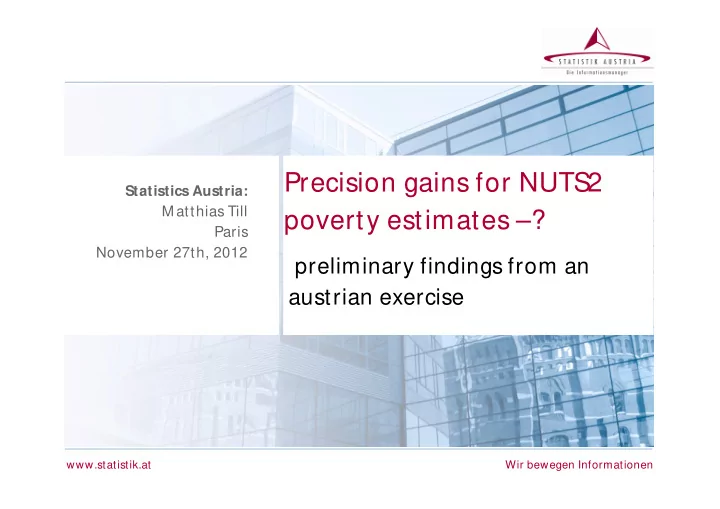

Precision gains for NUTS2 Statistics Austria: M atthias Till poverty estimates –? Paris November 27th, 2012 preliminary findings from an austrian exercise www.statistik.at Wir bewegen Informationen
Our problem: Eratic patterns over time APR (2005-10) 2005 2006 2007 2008 2009 2010 20 18 16 14 12 10 8 6 4 2 0 Oberösterreich Salzburg Tirol Vorarlberg Niederösterreich Steiermark Burgenland Kärnten Wien Statistics Austria Eu-SILC www.statistik.at Folie 2 | 09.04.2013
AT34: a special case APR (2005-10) 2005 2006 2007 2008 2009 2010 20 18 18 plus 40% 16 minus 37% 13 14 13 12 12 10 9 10 8 6 4 2 0 Vorarlberg Statistics Austria Eu-SILC www.statistik.at Folie 3 | 09.04.2013
Our problem: precision proportionate to region size NUTS 2 n= CI 247 4,7 AT11 not significantly different from AT13 (Vienna) AT34 307 3,6 AT32 440 3,0 AT21 475 4,3 AT33 584 2,6 AT22 1.014 2,4 AT13 1.219 2,4 AT31 1.233 2,2 AT12 1.287 1,8 Total 6.806 0,8 EU-SILC 2007, number of households, 95% confidence intervall for Poverty Rate Seite 4
Our solutions: • 1. Relying on direct estimates Inacceptable volatility for small regions • 2. Aggregation over several years cheap and easy but not timely and limited scope • 3. Augmenting income information in LFS (using registers) Larger (and in AT: disproportional sample design) quality concerns and unmet data requirements • 4. Imputing poverty status in LFS (using models) borrows statistical strength and can enhance understanding Unit level is most flexible and can be augmented with region covariates Overlapping core variables & micro data availability of LFS & EU-SILC Shrinkage towards the mean = bias of between region differences • 5. Composite of imputed (4) and direct (1) estimates M inimizes expected bias accross regions Reduces precision gain for small regions 11-13 May 2011 www.statistik.at Folie 5 | 09.04.2013 DDG Eurostat Laboratory
Recommend
More recommend